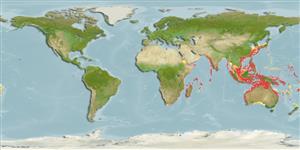Teleostei (teleosts) >
Aulopiformes (Grinners) >
Synodontidae (Lizardfishes) > Synodontinae
Etymology: Synodus: Greek, syn, symphysis = grown together + Greek, odous = teeth (Ref. 45335).
More on author: Day.
Environment: milieu / climate zone / depth range / distribution range
Ecology
Marine; reef-associated; depth range 20 - 100 m (Ref. 9710). Tropical
Indo-West Pacific: southern Red Sea and East Africa (Ref. 4055) to southern India and Sri Lanka. One specimen is known from the Philippines. Also reported from Indonesia and northwestern Australia (Ref. 5978).
Size / Weight / Age
Maturity: Lm ? range ? - ? cm
Max length : 33.0 cm TL male/unsexed; (Ref. 11228); common length : 12.0 cm TL male/unsexed; (Ref. 3520)
Dorsal
spines
(total): 0;
Dorsal
soft rays
(total): 11-13;
Anal
spines: 0;
Anal
soft rays: 9 - 11. Body dusky pink above, with pale blue-grey blotches and stripes; 2 black streaks at upper edge of operculum; caudal fin yellow in color; some with dark blotches along lateral line (Ref. 11228).
Found on current-prone (Ref. 48635) sand or mud bottoms (Ref. 11228), usually in depths of 20 m or more. Usually buries itself in the sand (Ref. 48635). Sold fresh and dried salted in markets.
Life cycle and mating behavior
Maturity | Reproduction | Spawning | Eggs | Fecundity | Larvae
Cressey, R.F. and R.S. Waples, 1984. Synodontidae. In W. Fischer and G. Bianchi (eds.) FAO species identification sheets for fishery purposes. Western Indian Ocean (Fishing Area 51). Volume 4. FAO, Rome. (Ref. 3520)
IUCN Red List Status (Ref. 130435)
Threat to humans
Harmless
Human uses
Fisheries: commercial
More information
Common namesSynonymsMetabolismPredatorsEcotoxicologyReproductionMaturitySpawningSpawning aggregationFecundityEggsEgg development
ReferencesAquacultureAquaculture profileStrainsGeneticsElectrophoresesHeritabilityDiseasesProcessingNutrientsMass conversion
Tools
Warning: mysqli::__construct(): (HY000/1040): Too many connections in /var/www/html/includes/speciessummary.lib.php on line 2414
Can't connect to MySQL database fbquizv2. Errorcode: Too many connections
